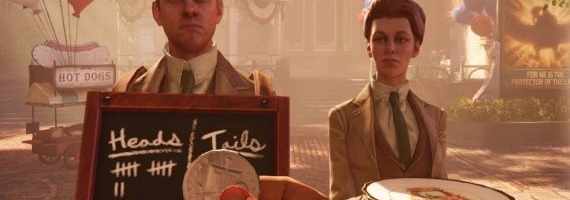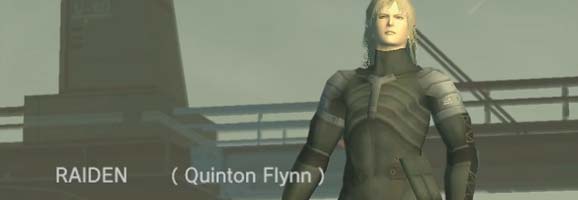Three Postmodern Games
In this post, Kevin Wong discusses three postmodern games featuring self-reflexivity and metacommentary

WARNING: Spoilers for Bioshock Infinite, Spec Ops: The Line, and Metal Gear Solid 2: Sons of Liberty follow!
Postmodernism is a bit of a loaded word within my circle of friends. Broadly defined, postmodernism is an “incredulity towards the metanarrative”, the rejection of a universal cultural mythos. The grand, Western narratives of religion, philosophy, and civilization were delegitimized by an increasingly globalized world filled with a plethora of worldviews; thus, relativism, subjectivity, and skepticism became the predominant response to the big questions. In the arts, postmodernism manifested as a mockery and challenge of previous conceptions of what art constitutes. Postmodern literature challenged the notion that narratives have to tell cohesive stories, Toni Morrison’s Beloved employs a fragmented narrative told by multiple narrators with subjective perceptions of reality and expects the reader to piece the plot back together and create their own subjective understanding. Marcel Duchamp challenged common understandings of what constitutes art by overturning a urinal and titling it Fountain.

“But is it art?” is a common question raised by postmodern art.
If video games are art, and all art forms undergo some postmodern phase where they question form and subjectivity, then examples of postmodern video games must exist. Indeed, if we are to look beyond their status as a cultural commodity and the indistinction between “high and low gamer culture”, there exists a rich practice of challenging prior conceptions of what the medium can do. The most common postmodern practivce in video games is self-reflexivity, when a work of art raises questions about itself as a created construct. Self-reflexivity most often manifests as the “breaking of the fourth wall”, when on-screen characters seemingly become aware of their existence in an electronic game and engage with the player directly. Taking cues from film and literature, story-driven games have cleverly deployed self-reflexivity to critique formal issues such as the narrative limitations imposed by interactivity, society’s attraction to violence in entertainment, and geek culture’s disinterest in reality.
Bioshock Infinite follows Booker DeWitt’s journey into the floating utopia of Columbia to retrieve a psychic girl named Elizabeth for mysterious employers. A popular reading of the game, (read: mine) frames it as a “meta-commentary” on the problematic nature of video game storytelling. In its ending, Bioshock Infinite introduces a plot twist revealing that the game exists in a multiverse, where an infinite number of alternate timelines are generated by every possible choice that a player makes in a game. The universes are characterized by “constants” and “variables”, elements of the plot that are consistently the same across playthroughs, and elements that differ depending on player choice. On a self-reflexive level, these terms refer to embedded and emergent narrative in games, “constants” being embedded narrative elements such as cutscenes, dialogue, and background chatter, and “variables” being emergent elements such as character customization and combat tactics. For games like Bioshock Infinite, narrative is delivered as an incomplete product, players must fill in the blanks that the authors have left, creating their own, personal, version ofBioshock Infinite.
That said, games like Bioshock Infinite are incapable of creating player agency because the designer authors all possible choices and outcomes. Players are constrained to only the narrative and strategic paths that designers create. While interactivity allows for a rich range of narrative permutations, all is mooted by authorial intent and a fixed story arc. Nonetheless, story-driven games constantly seek to combine authored narrative and player-agency despite the fact that the two inherently contradict each other. How can Mass Effector The Walking Dead provide a truly emergent, player-driven narrative when a writer pens all dialogue choices, determines where the story will go, and how it will all end?

Bioshock Infinite deals with the conflict between emergent and fixed narrative.
Bioshock Infinite self-reflexively critiques this trend mechanically and narratively. Many story-driven attempt to provide the illusion of agency by allowing the player to make binary or semi-binary choices at key moments to influence the direction of the plot. Bioshock Infinite subverts this mechanical trope by adopting similar “decision-moments” at certain points of the game, such as the decision to choose between two different brooches for Elizabeth. Bioshock Infinite subverts player expectations by making these binary “decision-moments” wholly irrelevant to the narrative, most often leading to minor cosmetic differences on a few side characters. The game knowingly acknowledges that players have been conditioned by similar games to believe that these “decision-moments” are critical its narrative outcome. By making these decisions comparatively irrelavant, Bioshock Infiniteraises the question of whether or not autonomy can exist when an omniscient game designer authors the outcomes of all these binary decision points, arguing that the pursuit of “narrative player agency” is futile.
A duo of characters named the Lutece Twins reinforces this critique of interactive narrative. The Luteces are extradimensional scientists who occasionally appear before Booker throughout his adventure, providing him with cryptic advice. They are based loosely off the titular characters of Tom Stoppard’s Rosencrantz and Guildenstern are Dead. In an early encounter, they hand Booker a coin and ask him to flip it, and it lands on heads, like it did for the last 122 times. A similar scene occurs in Rosencrantz and Guildenstern where the constant outcome of a coin-flip causes the characters to question whether an omniscient force dictates their existence. An omniscient force does indeed dictate the coin flip: Stoppard scripts the coin to always land on heads, just like how Bioshock Infinite’s coin is scripted to always land on heads. Thus, chaos and random chance cannot exist under the directorial omnipotence of an author.
The coin-flip scene in Bioshock Infinite represents an ideal point to give the player the choice to call heads or tails, but Booker is scripted to always call heads. This is meaningful within the context of the game; removing interactivity from the scene suggests that it is impossible for a scripted narrative to be truly player driven, and players have no choice in a story-driven game except to proceed down the designer-dictated narrative path.

The Lutece twins are the source of Bioshock Infinite’s most interesting metacommentary on fate and autonomy within story worlds.
While most story-driven games strive to make players autonomous agents enacting change upon the game’s world through their decisions, Bioshock Infinite posits that the nature of the medium prohibits this from happening because designer-authored narratives prohibit real autonomy. Rosencrantz and Guildenstern tried to escape their doom by fleeing to England, but they were rendered incapable of doing so by existing in an authored narrative. Because Booker DeWitt is a video game character, he ultimately has no agency over his decisions, as he is simply an avatar for the player. The player is in turn a non-autonomous actor controlled by the invisible hand of game design, she is unable to make choices outside of the ones that the game’s system allows and must continuously push Booker forward from chapter to chapter until the game concludes. Self-reflexivity manifests as metacommentary in Bioshock Infinite, which critiques the narrative limitations inherent to an interactive medium and the and Sisyphean pursuit of “player agency”.
Yager’s 2012 military shooter Spec Ops: The Line uses self-reflexivity to critique society’s attraction to violence in entertainment. Spec Ops follows Captain Walker, who goes through a surreal journey through a sand-buried Dubai, strongly suggested to be a personal hell.Spec Ops self-reflexively raises questions about the morality of enacting violence its own medium. This is achieved through the subversion of player expectations and visual pastiche of other games.

Spec Ops: The Line critiques societal attraction to violent entertainment.
Spec Ops: The Line questions player motivations and the attraction to violence by making its moment-to-moment gunplay banal and repetitive. The only mechanical progression appears in the escalating brutality of Walker’s execution moves, which questions player motivations for continuing to play the game in spite of the gunplay’s repetitious nature. Generic packaging, deceptive marketing, and a formulaic opening trick the player into believing Spec Ops to be a standard Call of Duty knockoff. The game’s deliberate manipulation of player expectations allows it to harshly indict those players who were actually seeking cheap thrills or escapist fantasy from it.
The game’s story punishes player progression: Walker’s time in Dubai only gets darker, more surreal, and nonsensical as the game progresses, subverting the genre’s “empowerment fantasy” through ludonarrative dissonance. Spec Ops’ ending has Captain Walker confront Colonel Konrad, a projection of his subconscious guilt. Konrad dances along the fourth wall in this climactic sequence, stating that everything would have been better if Walker simply left Dubai. In context, this suggests that simply quitting and leaving the game unfinished would have been considered a legitimate, and far less destructive, conclusion to the game’s story.
Much like Bioshock Infinite, Spec Ops deals with the impossibility of free will in a story-driven game. Throughout his mission, Captain Walker consistently shifts culpability over his destructive actions onto Konrad, claiming that he left him with no choice. Given the game’s structure, it is inherently impossible for Walker to not cause the damage he does; the only way to progress in a shooter like Spec Ops is to kill people. Walker’s shifting of the blame onto Konrad, claiming that he was left without any choice, reflects the player’s shifting of culpability onto the game’s design, which provokes frustration within the player by leaving no choice but to proceed by causing paramount death and suffering in Dubai.
Outside of meta-commentary on choice and culpability, Spec Ops critiques the attraction to violent military shooters by employing visual pastiche of other games, most notably, entries in the Call of Duty franchise. A key sequence in Spec Ops pastiches the “Death from Above” level from Call of Duty 4: Modern Warfare. The game takes a satellite view of the battlefield as Walker uses a white phosphorus cannon against a battalion of soldiers. The player, trained by similar sequences in other games, is subconsciously attracted to firing upon large groups of enemies (represented by white dots) and explosive vehicles, as doing so leads to a high bodycount: a good thing in “Death from Above”. This tricks players by making the largest group of “enemies” fired upon a group of innocent refugees. By recontextualizing Call of Duty 4’s most revered level, Spec Ops deconstructs player expectations of what actions are rewarded in the context of a game’s narrative, causing uncanny discomfort, if not rage, in its players.

Walker fires a white phosphorus cannon upon a battalion of troops.
Spec Ops’ particular deployment of pastiche is self-reflexive because it acknowledges its own artificiality by adopting tropes from other games to raise issues about those games as a whole. Structurally, Spec Ops’ denouement is almost identical to Call of Duty: Modern Warfare 3’s. Both involve the protagonist storming the villain’s tower at the center of Dubai, ascending to the top floor for a final confrontation. Spec Ops derisively mocks Call of Dutyby removing combat from this final confrontation as the few surviving enemy soldiers surrender. Walker ascends the tower to confront Konrad only to discover that the villain was ultimately imaginary. As the game concludes, Konrad addresses the player directly, “You’re here because you wanted to feel like something you’re not, a hero”, he says, as he raises a gun to Walker.
As a cohesive whole, Spec Ops looks beyond its own fiction, pointing its metaphorical crosshairs at the recent surfeit of military shooters. By pastiching popular games in the genre and depicting a narrative where player participation is destructive to the game world,Spec Ops raises questions about the fantastical nature of military shooters and society’s attraction to violence in its entertainment. Konrad posits that players are attracted to violent action games to fulfill a desire for self-glorification in a morally diametric world, deconstructing the shooter’s narrative of the power fantasy.
While the Metal Gear Solid series is known for a psychic commando who acknowledged his own artificiality by reading the player’s memory card, the series’ second game, Sons of Liberty, offers much more interesting examples of postmodern self-reflexivity. Metal Gear Solid 2 indicts and deconstructs geek culture and game sequels by subverting player expectations in an increasingly over-the-top way. These subversions begin with the game’s marketing within the context of its release.
The first Metal Gear Solid was one of the runaway hits of the Playstation era, selling several million copies and spawning an eager fandom clamoring for a sequel. The game’s creative director, Hideo Kojima, intended for the game to be a one-off project, and had no plans to continue with the series. Fans became so vehement that Konami eventually gave in and had Kojima start work on a sequel. The initial trailers marketed Metal Gear Solid 2 as an epic continuation of Solid Snake’s adventure, and it quickly became one of the most anticipated and expensive games of its time. When it was released, the game was everything that fans dreamed of. The opening Tanker mission was creatively designed, featured few game-interrupting codec sequences, and had ample fan-pleasing dialogue between beloved characters. The whole thing was excitingly paced and represented the exact kind of sequel that fans clamored for. That is, until the Tanker sank and Snake apparently died.

Metal Gear Solid 2 was one of the most anticipated games of its time.
After that integral plot twist, players take control of Raiden, a golden-haired, effeminate, and oft-whiny operative, with extensive experience in virtual reality missions but no actual experience in the field of combat. Kojima was cognizant that fans would be infuriated at the realization that they would be controlling the unlikable Raiden for the rest of the game, and deliberately designed the opening sequences of his mission poorly. While the Tanker mission featured few gameplay interruptions and sophisticated level design that gave experienced players a lot of strategic freedom, Raiden’s mission was consistently interrupted by long-winded, unnecessary tutorials and Raiden slavishly taking orders from his superiors. The plot disregards the series’ fiction by jumping from magical-realism to histrionic silliness, introducing goofy twists such as vampires, a rollerskating fat man, and an Illuminati-like superpower. All this is reinforced by the game’s advertising, from which Raiden was completely absent. Raiden’s introduction contradicted practically all fan expectations of a proper sequel to Metal Gear Solid, and their outrage at being treated this way was palpable.
But thematically and artistically, Metal Gear Solid 2’s false-advertising and savaging of its own fanbase makes total sense. Raiden was trained as a soldier through virtual reality, playing through simulations of Snake’s previous missions, each of them “indistinguishable from the real thing”. In context, Raiden represents geek culture, he believes that he is qualified for his mission because he played as Snake in combat simulations, lending him a strange inability to grasp the increasingly surreal nature of his adventure. In postmodern philosophy, the term “hyperreality” refers to the inability of a consciousness to distinguish between reality and a simulation of reality, a habitual problem that geek and otaku culture is accused of suffering from. An incessant torrent of plot twists and gameplay sequences impounds this hyperreality, as the game continues, it is revealed that Raiden’s support team is really an AI simulation of Colonel Campbell and Rose, Raiden’s girlfriend, and that his entire mission was nothing but an elaborate simulation intended to condition Raiden into becoming the perfect replication of Solid Snake. In its final chapters, the game grows increasingly strange, code spews through walls, characters literally turn on infinite ammo cheats, and the game abandons its stealth mechanics with an ultraviolent shootout against a horde of ninjas. The penultimate confrontation pits Raiden against an army of giant robots in a TRON-like arena as pounding techno plays in the background. By the time the player physically encounters Rose at the game’s conclusion, the player is filled with doubt and confusion over whether or not what she sees is real, even in the context of the game.

Fans didn’t ask for this…
Which all makes sense given Kojima’s initial reluctance to make Metal Gear Solid 2 in the first place. Postmodern themes like hyperreality, simulation, and simulacra, in combination with Raiden’s unwanted presence and the ambiguity of the entire plot, all alienate the hardcore fans that irked Konami for a sequel. As the game ends, Raiden rejects the player’s control by taking out a pair of dog tags labeled with the player’s name and throwing them into the distance. In a closing monologue, Snake asks the player to embrace subjectivity and disregard the search for an objective reality.
Granted, this is not the only valid interpretation of Metal Gear Solid 2, and much better writings exist from Leigh Alexander and Brett Fujioka, but the focus of this article is on video games that self-reflexively raise issues about their medium, and Metal Gear Solid 2 accomplishes this by subverting fan expectations of a sequel. For detailed analysis of Japanese postmodernism and Otaku culture, consider reading Hiroki Azuma’s “The Animalization of Otaku Culture”.
There are a number of games that I have not been able to cover in this article, such asHotline Miami, a ludic condemnation of narrative games, and The Stanley Parable, which dances around the player-avatar-designer relationship with wit and humor. That said, these postmodern “games about games” all raise very interesting questions about the artificiality of fiction, player expectations, and relativism, giving developers very interesting material to design responses off of. If anything, the deconstruction of game-related issues prompts creative responses and better understandings of what an interactive medium can and cannot accomplish.
Read more about:
BlogsAbout the Author(s)
You May Also Like







.jpeg?width=700&auto=webp&quality=80&disable=upscale)








